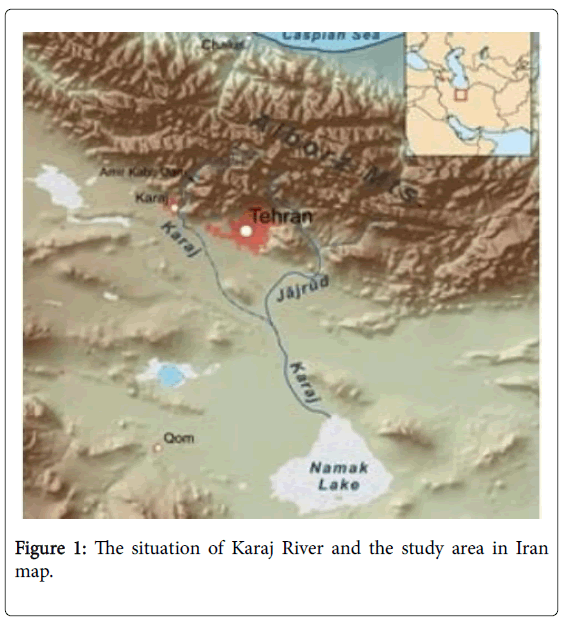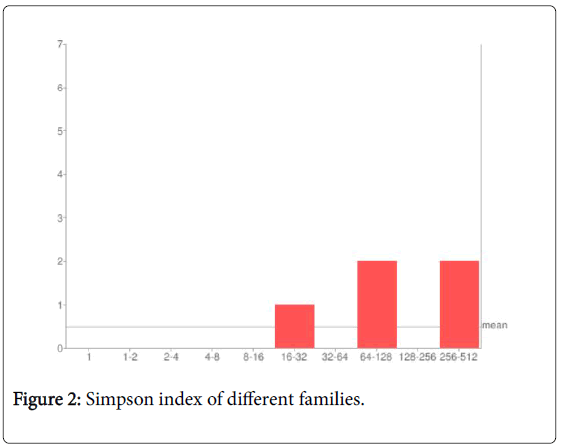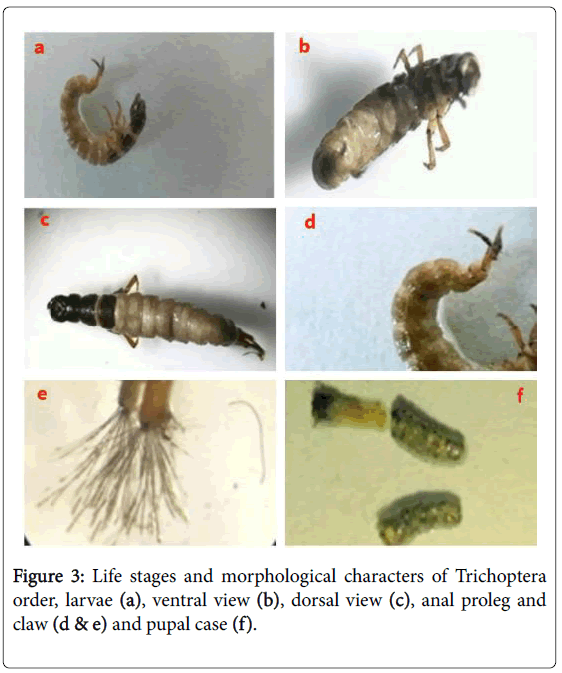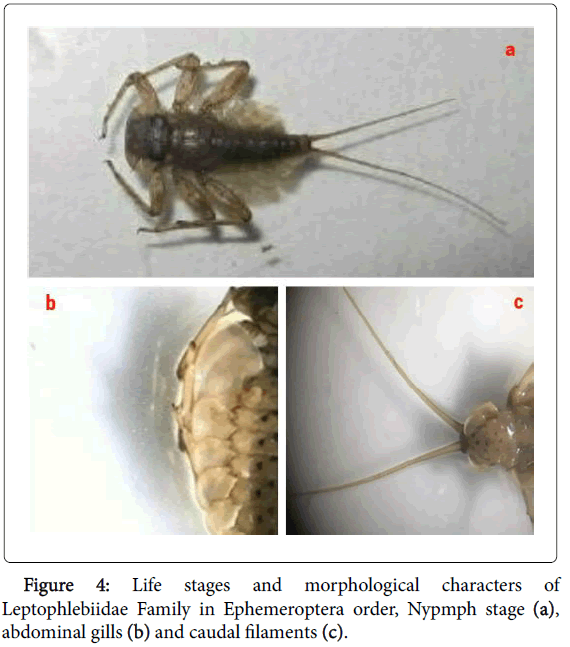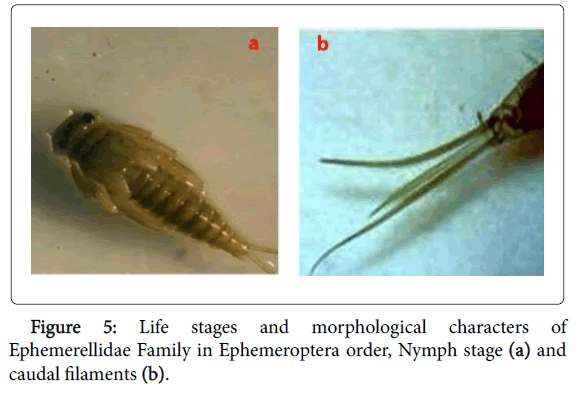The Species Diversity of Aquatic Insects in Karaj River, Central Iran
Received: 09-Aug-2018 / Accepted Date: 21-Aug-2018 / Published Date: 25-Aug-2018 DOI: 10.4172/2155-9910.1000258
Keywords: Aquatic insect; Fauna; Iran
Introduction
Aquatic insects are important group of insects in the aquatic ecosystem and they occupy various aquatic environments [1]. They play an important role in the ecological dynamics and in monitoring the health of aquatic environments [2]. Some of these aquatic insects are beneficial to humans while some are dangerous [3]. Many insect orders such as: Diptera, Ephemeroptera, Plecoptera, Trichoptera, Neuroptera, Odonata and Hymenoptera spend most of their immature stages in water while the adults are terrestrial [4]. Ephemeroptera, Plecoptera and Trichoptera (EPT) richness are very useful for the detection of metal pollution in streams. On the other hand, EPT species are often used as biological indicator of water quality [5]. A range of factors (temperature, altitude, season, total suspended solids and vegetation) control the diversity of aquatic insects [6]. Vectors of some infectious diseases like Malaria, Dengue fever, West Nile fever and Filariasis are water-dependent [7]. Dragonfly and damselfly are the host of the trematode Haematoloechus longiplexus , they are predators, both in their aquatic larval stage, where they are known as nymphs or naiads and as adults [8].
According to a study in USA by Wallace et al. [9], entomologists used unique case-building behaviors of the Limnephilidae caddisflies found on a human corpse to reveal a post-mortem submersion interval range consistent with the disappearance of the victim. Thus aquatic insects can be used in medico-legal entomology for estimation of postmortem submersion interval to solve crime problems. Some families of the order Odonata, Ephemeroptera, Hemiptera, Trichoptera, Coleoptera and Diptera have been reported from Iran [2,3]. Aquatic entomology is a neglected field of study in Iran and in order to establish a baseline data‚ studies of this nature are needed which will eventually lead to advancement in the field of aquatic entomology investigations. The aim of this study was to establish a baseline data of aquatic insects faunal in Karaj district of Alborz province, northern Iran.
Material and Methods
Study area
Karaj River (Rud-e Karaj ), is the second major permanent river in the central Iranian plateau after the Zayandarud river. The river runs 245 km, with an average slope of 0.8 percent, average annual discharge of 499 mcm (million cubic meters), and precipitation of 625 mm; the basin area is 2,800 km2. It flows from the central Alborz sierra through the city of Karaj and the irrigated plain of Shahriar, then with its tributary Jajrood River meeting in Tehran Province to empty into the Namak Lake basin in Qom Province. The Amir Kabir Dam was constructed across the river for water supply, electricity and irrigation in Tehran, Iran (Figure 1).
Sampling technique
The study was conducted in the spring of 2017; samples were collected from five different points using several methods including Dframe nets, dipping, direct search in the river floor stones, aquatic vegetation, over hanging terrestrial vegetation, within burrows, leaf packs and fine sediments. All of the specimens collected were preserved in 70% alcohol container well labeled with the dates of collection, location of study area, temperature and humidity then transferred to the laboratory of medical entomology department, Tehran University of Medical Sciences. Standard keys and stereo-typed microscope were used to identify the samples in the laboratory [10-12]. Table 1 shows the physical characteristics of breeding places.
| Temperature (°C) |
pH | BOD (mg/l) | Nitrate (mg/l) | Amonia (mg/l) | Total Coliform (n/100 ml) |
|---|---|---|---|---|---|
| 20 ± 2 | 8.2 | 1.5 | 2.98 | 0.14 | 100850 |
Table 1: Physicochemical properties of Karaj River. Information includes mean temperature, scale of acidity (PH), biological oxygen demand (BOD), scale of Nitrate, Ammonia and Coliform Bacteria in sample sites.
Results
During the sampling in Karaj river, a total of 436 specimens were collected belonging to 3 orders (Ephemeroptera, Trichoptera, Diptera) 5 families (Leptophlebiidae, Ephemerellidae, Helicopsychidae, Hydropsychidae, Chironomidae) Table 2.
The most predominant family was Hydropsychidae (42.4%) while Chironomidae had the lowest population size (1.83%). In this study, the Tricoptera order was the predominant with 223 (51.1%) collection while Diptera was the least order with only 8 (1.83%) collections. The Simpson indexes are presented in Table 3 and Figure 2. All the samples collected (100%) were in their nymphal and larvae stages of development. Two families were collected from Ephemeroptera order, 2 families from Trichptera order and one family was obtained from Diptera order Table 2, Figures 3-5.
| Order | Family | No. | Percentage % |
|---|---|---|---|
| Ephemeroptera | Leptophlebiidae | 164 | 37.6 |
| Ephemerellidae | 41 | 9.4 | |
| Trichoptera | Helicopsyche | 38 | 8.7 |
| Hydropsychidae | 185 | 42.4 | |
| Diptera | Chironomidae | 8 | 1.8 |
| Total | 5 | 436 | 100 |
Table 2: Aquatic insects collected from the various sampling sites, Karaj River.
| Simpson Index | 0.3379 |
| Dominance Index | 0.6621 |
| Reciprocal Simpson Index | 2.959 |
| Shannon Index | 1.787 |
| Shannon Index | 1.239 |
| Shannon Index | -0.538 |
| Menhinick Index | 0.1582 |
| Buzas and Gibson's Index | 0.6903 |
| Equitability Index | 0.7697 |
Table 3: Simpson Index of different families of aquatic insects collected.
Discussion
In this study, we collected various species of aquatic insects. A total of 436 samples belonging to 3 Orders and 5 families were identified using stereo microscope and standard keys. This study had more species diversity compared to other similar studies on aquatic insects reported from Iran. The order Trichoptera was the predominant sample collected (51.1%) while Diptera was the lowest order collected (1.83%) Table 2. In a recent study, two families of Ephemeroptera (leptophlebiidae, Ephemerellidae) and two families of trichoptera (Helicopsyche, Hydropsychidae) and one family named Chironomidae belonging to the order Diptera were identified. In another similar research one family of trichoptera (Hydropsychidae) and Heptagenidae family belonging to Ephemeroptera were reported from Karaj River, but Diptera was not found instead they collected two families of Plecoptera order including perlidae and perlodidae [13]. A study carried out by Shayeghi et al. [14] in Zayande Roud River, the samples collected constituted more than 50% of the order Diptera (Culicidae, Syrphidae, Chironomidae) and Trichoptera. The most predominant family was Hydropsychidae (42.4%). Fauna of aquatic insects in sewage maturation ponds of Kashan have been reported. A similar study conducted in the study area by Dehghani et al. [15] is in agreement with the results we obtained, where they reported Chironomidae and Hydrophilidae families as the most prevalent in the study area similar to our findings. Shayeghi et al. [16] in another related study from Sablan River in Ardabil province, reported the two families of the order Diptera (Trichoptera Plecoptera) as the most prevalent (61%) which is similar to our study (Trichoptera 51.1%). They also reported 3 families belonging to Diptera order (Culicidae, Simulidae, Chironomidae). The families of Chironomidae and Hydrophilidae were prevalent. In the other study that conducted by Vafaei et al. [17] for surveying of the aquatic beetles (Coleoptera: polyphaga) of Markazi Province (central Iran) after investigation in freshwater habitats of study area, 24 species (Coleoptera: Hydrophilidae, Helophoridae, Hydraenidae, Elmidae, and Dryopidae) belonging to 13 genera and five families were identified and in this study Hydrophilidae family was one of the collected samples like present study. Some aquatic insects are an important for biological control of larvae and adults of mosquitoes in the breeding places also some of these insects play an important role in transmission of some human and animal diseases. Anopheles culicifacies s.l. , An. stephensi , An. dthali , An. fluviatilis s.l. , An. superpictus , are known to be the malaria vectors [18-30]. Therefore, the ecological specifications of these insects could provide a clue for further Arthropod-borne disease control.
References
- Abhijna UG, Ratheesh R, Kumar AB (2013) Distribution and diversity of aquatic insects of Vellayani lake in Kerala. J Env Biol 34: 605.
- Malekei-Ravasan N, Bahrami A, Shayeghi M, Oshaghi MA, Malek M, et al. (2013) Notes on the Iran Caddisflies and role of Annulipalpian hydropsychid Caddisflies as a bio-monitoring agent. J Arthropod-borne Diseases 7: 71-82.
- Ahmadi R, Mohebbi F, Hagigi P, Esmailly L, Salmanzadeh R (2011) Macro-invertebrates in the Wetlands of the Zarrineh estuary at the south of Urmia Lake (Iran). Int J Environ Res 5: 1047-1052.
- McCafferty WP (1981) Aquatic entomology: the fisherman’s and ecologist’s illustrated guide to insects and their relatives. Science Book International, Boston, MA.
- Kiffney PM, Clements WH (1996) Effects of metals on stream macroinvertebrate assemblages from different altitudes. Ecol Appl 6: 472-481.
- Crisci-Bispo VL, Bispo PC, Froehlich CG (2007) Ephemeroptera, Plecoptera and Trichoptera assemblages in two Atlantic rainforest streams, Southeastern Brazil. Revista Brasileira de Zoologia 24: 312-318.
- Sutherst RW (2004) Global change and human vulnerability to vector-borne diseases. Clin Microb Rev 17: 136-173.
- Novak CW, Goater TM (2013) Introduced bullfrogs and their parasites: Haematoloechus longiplexus (Trematoda) exploits diverse damselfly intermediate hosts on Vancouver Island. The J Parasitol 99: 59-63.
- Wallace JR, Merritt RW, Kimbirauskas R, Benbow ME, McIntosh M (2008) Caddisflies assist with homicide case: determining a postmortem submersion interval using aquatic insects. J Forensic Sci 53: 219-221.
- Clifford HF (1991) Aquatic invertebrates of Alberta: An illustrated guide. University of Alberta. American Library Association 29: 29–6273.
- Borror DJ, White RE (1998) A field guide to insects: America north of Mexico. Houghton Mifflin Harcourt.
- Subramanian KA, Sivaramakrishnan KG (2007) Aquatic Insects of India-A Field Guide. Ashoka Trust for Ecology and Environment (ATREE), Bangalore, India. p 62.
- Shayeghi M, Vatandoost H, Gorouhi A, Sanei-Dehkordi AR, Salim-Abadi Y, et al. (2014) Biodiversity of aquatic insects of Zayandeh Roud River and its branches, Isfahan Province, Iran. J Arthropod-borne Diseases 8: 197.
- Shayeghi M, Nejati J, Shirani-Bidabadi L, Koosha M, Badakhshan M, et al. (2015) Assessing the fauna of aquatic insects for possible use for malaria vector control in large river, central Iran. Acta Medica Iranica 53: 523-532.
- Dehghani R, Miranzadeh MB, Yosefzadeh M, Zamani S (2007) Fauna aquatic insects in sewage maturation ponds of Kashan University of Medical Science 2005. Pak J Biol Sci 10: 928-931.
- Shayeghi M, Moradi AE, Saeidi Z, Mozafari E, Poudat A, et al. (2016) Aquatic insects fauna of Meshkin Shahr, Ardabil Province, northwestern Iran 2014. J Marine Sci: Res Dev 6.
- Vafaei R, Ostovan H, Incekara U, Pesic V (2007) Faunistic study of the aquatic beetles (Coleoptera: Polyphaga) of Markazi Province (Central Iran) with new records. Arch Biol Sci 59: 239-242.
- Doosti S, Azari-Hamidian S, Vatoost H, Hosseini MO (2006) Taxonomic differentiation of Anopheles sacharovi and An. maculipennis sl (Diptera: Culicidae) larvae by seta 2 (antepalmate hair). Acta Medica Iranica 44: 21-27.
- Hanafi-Bojd AA, Azari-Hamidian S, Hassan V, Zabihollah C (2011) Spatio—temporal distribution of malaria vectors (Diptera: Culicidae) across different climatic zones of Iran. Asian Pacific J Tropic Med 4: 498-504.
- Hanafi-Bojd AA, Vatandoost H, Oshaghi MA, Charrahy Z, Haghdoost AA, et al. (2012) Spatial analysis and mapping of malaria risk in an endemic area, south of Iran: a GIS based decision making for planning of control. Acta tropica 122: 132-137.
- Hanafi-Bojd AA, Vatandoost H, Oshaghi MA, Charrahy Z, Haghdoost AA, et al. (2012) Larval habitats and biodiversity of anopheline mosquitoes (Diptera: Culicidae) in a malarious area of southern Iran. J Vector borne Diseas 49: 91-100.
- Hanafi-Bojd AA, Vatandoost H, Oshaghi MA, Haghdoost AA, Shahi M, et al. (2012) Entomological and epidemiological attributes for malaria transmission and implementation of vector control in southern Iran. Acta Tropica 121: 85-92.
Citation: Vatandoost H, Moosa-Kazemi SH, Tavasoli M, Badzohre A, Keshavarzi D, et al. (2018) The Species Diversity of Aquatic Insects in Karaj River, Central Iran. J Marine Sci Res Dev 8:258. DOI: 10.4172/2155-9910.1000258
Copyright: © 2018 Vatandoost H, et al. This is an open-access article distributed under the terms of the Creative Commons Attribution License, which permits unrestricted use, distribution, and reproduction in any medium, provided the original author and source are credited.
Select your language of interest to view the total content in your interested language
Share This Article
Recommended Journals
Open Access Journals
Article Tools
Article Usage
- Total views: 4976
- [From(publication date): 0-2018 - Jun 24, 2025]
- Breakdown by view type
- HTML page views: 4021
- PDF downloads: 955

